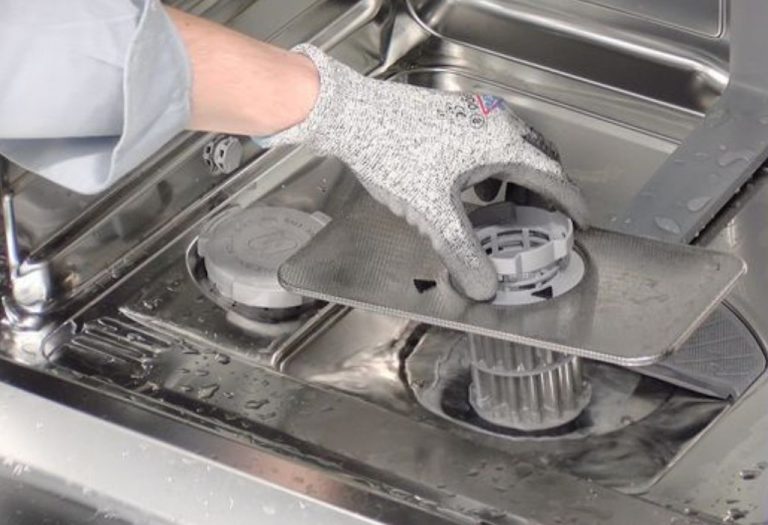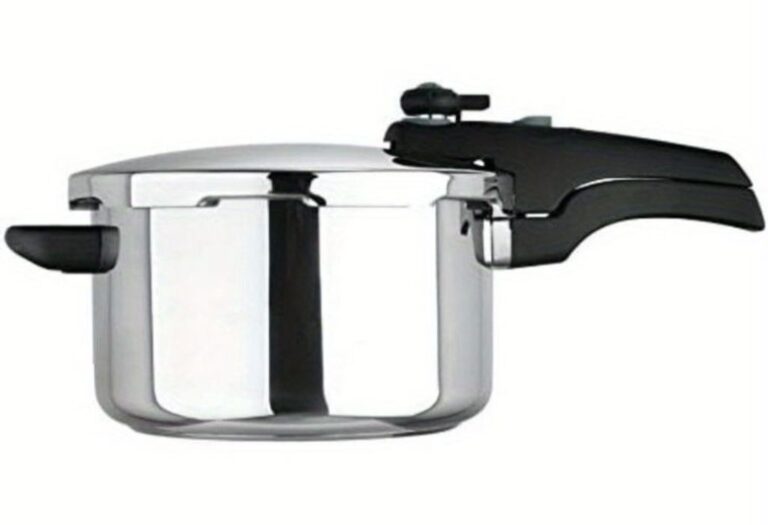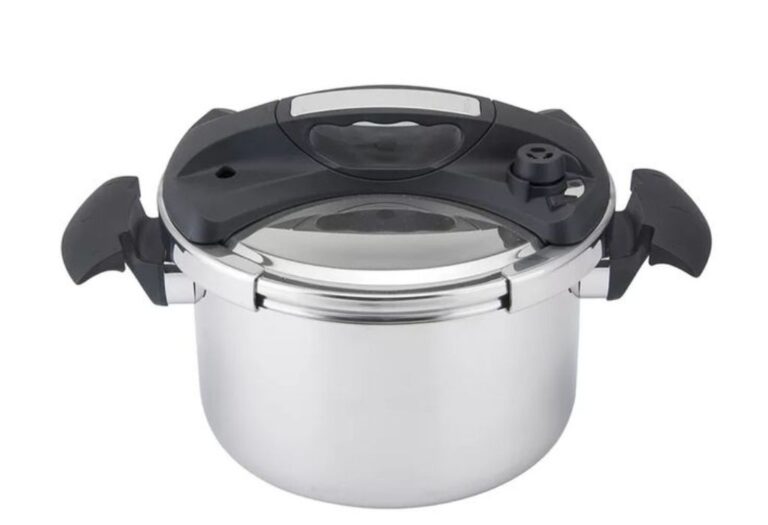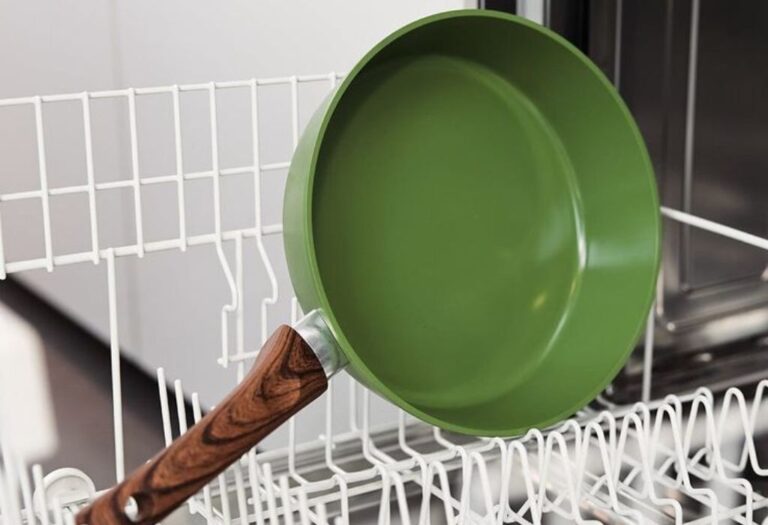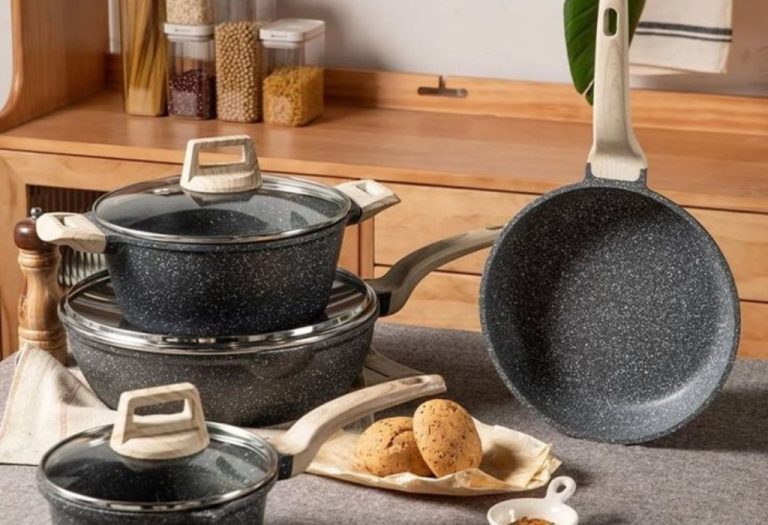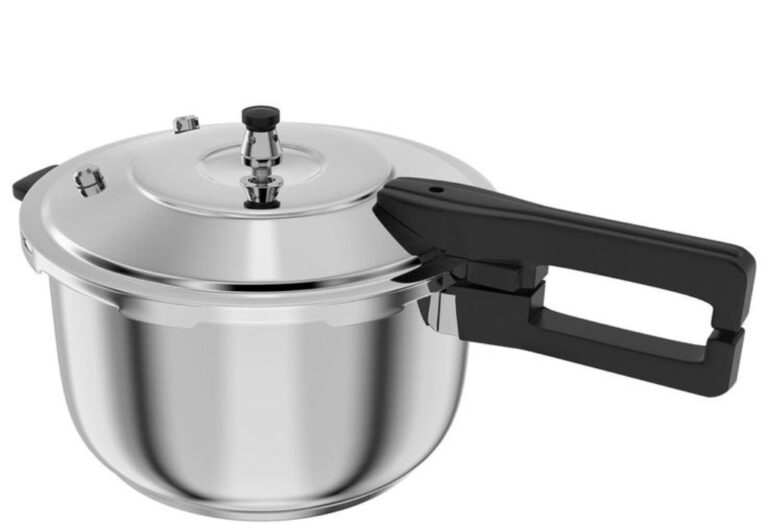Imagine standing in the cookware aisle, surrounded by labels shouting “non-toxic,” “eco-friendly,” and “PFAS-free.”
The options look promising, but the question lingers: does ceramic cookware have PFAS, or are these claims too good to be true?
The problem is not small.
PFAS, often called “forever chemicals,” persist in the environment and the human body for decades, raising health concerns across the globe.
Curiosity grows as studies uncover unsettling links.
According to the American Cancer Society, exposure to PFAS like PFOA may increase the risk of kidney and testicular cancer (source).
Another report by the Environmental Working Group notes that more than 200 million Americans could have PFAS in their drinking water supply (source).
With risks this widespread, even cookware choices start to feel more critical than ever.
The benefit of clarity is powerful.
By understanding what ceramic cookware really is, how coatings differ, and what research says about PFAS contamination, readers gain control over healthier kitchen decisions.
What Are PFAS and Why Do They Matter?
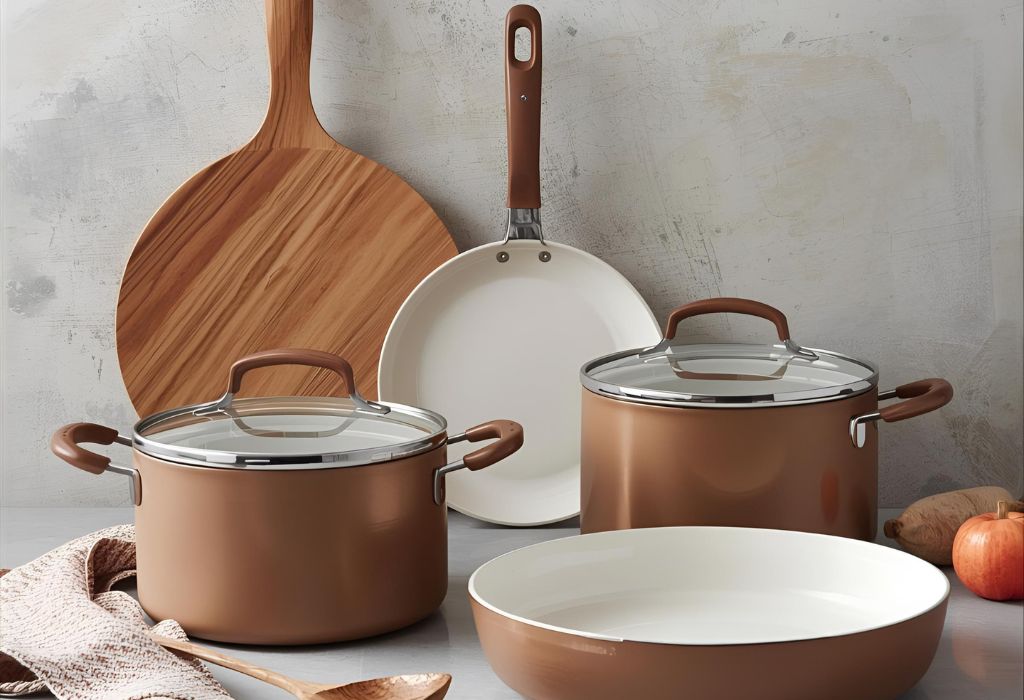
PFAS, short for per- and polyfluoroalkyl substances, are a large group of man-made chemicals used in everything from food packaging to firefighting foams.
They are often called “forever chemicals” because they do not break down naturally and can remain in the environment and the human body for years.
These substances include well-known compounds such as PFOA, PFOS, and PTFE.
Each has been linked to concerns about long-term health effects and widespread environmental pollution.
According to the U.S. Environmental Protection Agency, even low levels of PFAS exposure have been associated with developmental effects in children and increased cancer risks (source).
The persistence of PFAS in water, soil, and food sources makes them nearly impossible to avoid without careful choices.
When cookware contains PFAS-based coatings, heat and wear can release harmful particles or fumes.
This is why many consumers are questioning whether “PFAS-free” cookware, such as ceramic, truly lives up to its promise.
Understanding PFAS is not just about chemical names but about recognizing why they matter in everyday life.
They represent an invisible risk that builds up over time, making cookware safety a real priority for households.
Q: What is PTFE, and how is it connected to PFAS?
A: PTFE is a polymer within the PFAS family, commonly used in traditional nonstick coatings.
Q: Are all PFAS banned or restricted?
A: No, only some like PFOA and PFOS face bans, while thousands of others remain in use.
Q: How does PFAS exposure occur from cookware?
A: Heat, scratching, or chemical breakdown can release PFAS into food or air.
Q: What levels of PFAS exposure are considered dangerous?
A: Even trace amounts can be risky over time, according to regulatory agencies.
Q: Why are PFAS called “forever chemicals”?
A: Because they do not degrade naturally and accumulate in the environment and human tissue.
What Does “Ceramic Cookware” Actually Mean?
Ceramic cookware can mean very different things depending on how it is made and marketed.
Some products are true ceramic, created from natural clay and minerals that are hardened at extremely high temperatures.
Others are metal pans coated with a ceramic-based sol-gel finish.
These coatings are made from silica and other compounds that give a smooth, nonstick-like surface without using traditional PTFE.
The marketing adds to the confusion.
Labels like “toxin-free,” “eco-friendly,” and “healthy nonstick” are often used interchangeably, even when products vary greatly in their composition.
True ceramic or porcelain enamel cookware does not rely on synthetic fluoropolymers.
However, ceramic-coated pans may differ in durability, performance, and long-term safety depending on the manufacturer.
Understanding these differences is essential when asking if ceramic cookware contains PFAS.
A pure clay pot baked in a kiln is not the same as a metal pan with a thin ceramic nonstick layer.
Q: Does a ceramic nonstick pan always mean PFAS-free?
A: Not always, because some coatings may still include synthetic polymers or additives.
Q: Can sol-gel ceramic coatings contain PFAS?
A: In most cases they are marketed as PFAS-free, but quality control varies by brand.
Q: How can you tell if cookware is truly ceramic or ceramic-coated?
A: Check the base material, heat resistance, and product labeling for details.
Q: Why do brands use terms like “green” or “eco cookware”?
A: These are marketing terms meant to appeal to health-conscious buyers and are not strictly regulated.
Q: Is porcelain enamel the same as ceramic cookware?
A: Porcelain enamel is a type of ceramic coating fused to metal, and it is typically free from PFAS.
Does Ceramic Cookware Have PFAS? What Tests and Research Say
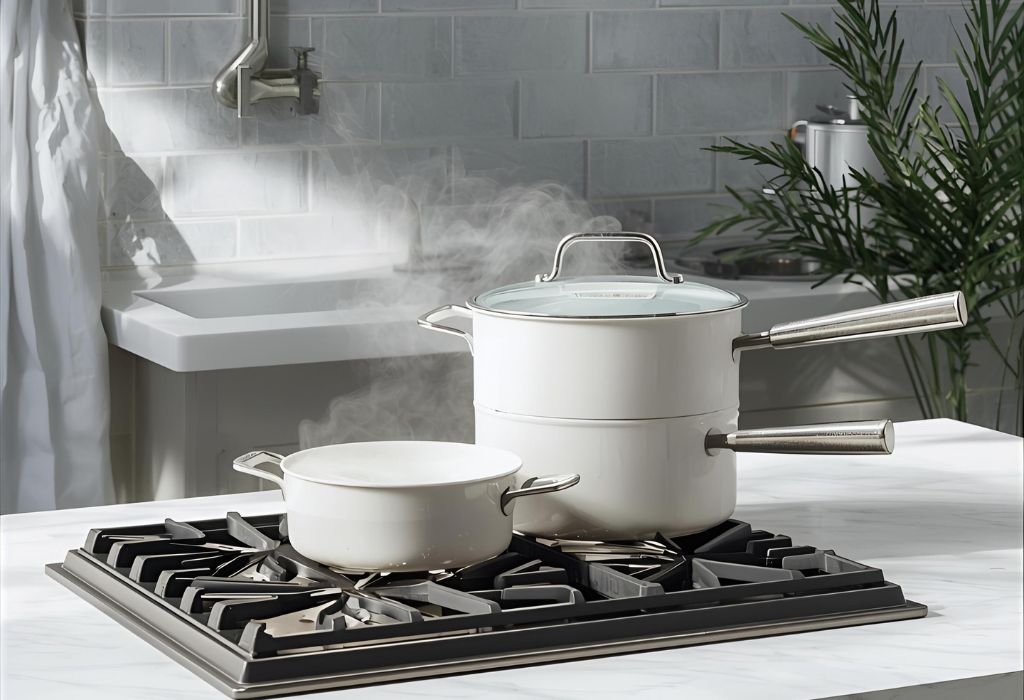
The core question many shoppers ask is whether ceramic cookware contains PFAS at all.
The answer depends on the type of ceramic and the transparency of the manufacturer.
Independent lab tests have shown that true ceramic cookware made from clay and natural minerals generally does not contain PFAS.
However, some ceramic-coated nonstick pans may still raise questions if production involves additives or unverified coatings.
A 2022 Consumer Reports investigation found that while most ceramic nonstick pans were PFAS-free, some products labeled as “green” or “eco” contained other chemicals of concern (source).
This highlights the importance of independent testing rather than relying solely on labels.
Heat also plays a role in safety.
When cookware is overheated beyond its recommended limit, coatings may degrade faster, which increases the risk of chemical release.
Scratches, chips, and abrasions weaken the surface of ceramic nonstick pans.
This not only reduces performance but may also raise safety concerns if other materials are exposed.
Q: Have tests detected PFAS in ceramic cookware marketed as PFAS-free?
A: Rarely, but occasional reports suggest the need for more oversight and independent verification.
Q: Is ceramic cookware completely risk-free at high heat?
A: No, excessive heat can still damage coatings and shorten their safe lifespan.
Q: Do scratches and chips increase the chance of contamination?
A: Yes, a damaged surface can expose underlying layers and reduce cookware safety.
Q: Are PFAS more common in ceramic-coated nonstick than pure ceramic?
A: Yes, pure ceramic cookware rarely contains PFAS, but coatings may vary by brand.
Q: Can brand reputation guarantee PFAS-free cookware?
A: A strong brand helps, but independent test results and certifications are the most reliable assurance.
Health Impacts and Safety Concerns
PFAS exposure has been linked to a wide range of health issues that extend beyond the kitchen.
These include increased cancer risks, hormone disruption, immune system suppression, and developmental problems in children.
The American Cancer Society notes that exposure to compounds like PFOA can raise the risk of kidney and testicular cancer (source).
Other studies have connected PFAS with thyroid disease and reduced vaccine effectiveness in children (source).
Although cookware is only one potential source of PFAS exposure, it adds to cumulative risks.
Water, food packaging, and household dust already contribute significantly to daily intake.
Compared to traditional PTFE-based nonstick pans, ceramic cookware is generally safer when it is genuinely PFAS-free.
However, poor quality or damaged ceramic coatings can still compromise safety if other harmful substances are present.
Understanding these risks helps consumers place cookware in the bigger picture of overall health protection.
Small choices, like selecting verified PFAS-free ceramic products, can reduce long-term exposure.
Q: How dangerous is low-level PFAS exposure from cookware?
A: Even small amounts may be concerning when combined with other daily exposures.
Q: Are children and pregnant women more vulnerable?
A: Yes, PFAS can interfere with fetal development and immune growth in young children.
Q: Does ceramic cookware reduce risk compared to Teflon pans?
A: Yes, when the cookware is truly PFAS-free and well maintained.
Q: Can PFAS affect hormones and metabolism?
A: Studies suggest links between PFAS exposure and thyroid disruption as well as weight gain.
Q: Should PFAS exposure be considered a long-term or short-term risk?
A: It is mainly a long-term risk because PFAS accumulate in the body and environment.
How to Choose Truly PFAS-Free Ceramic Cookware
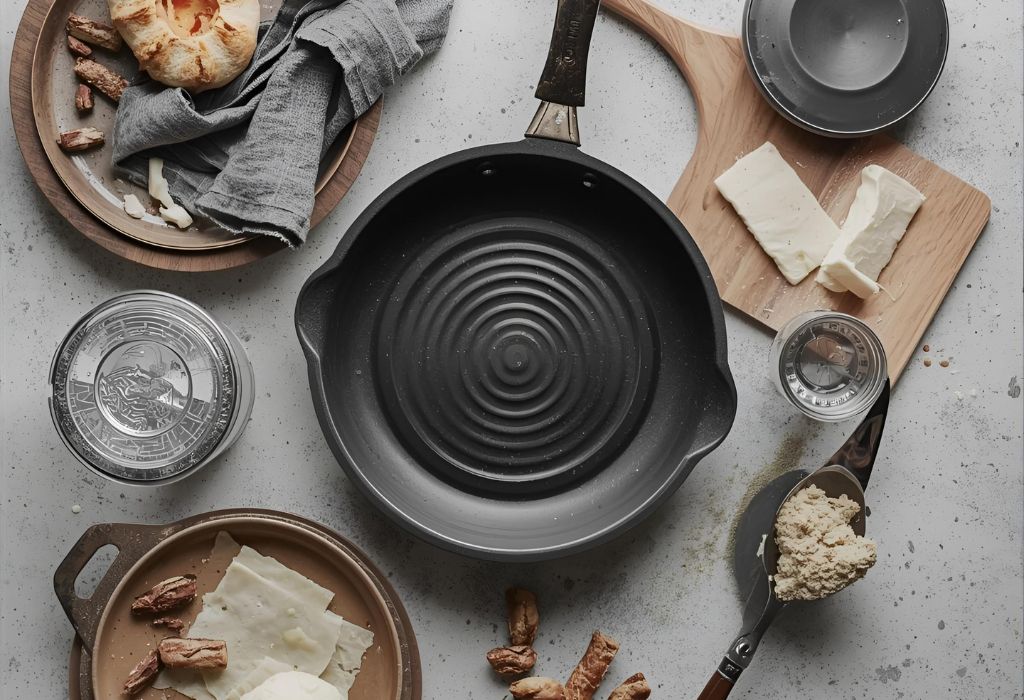
Selecting safe cookware requires more than trusting a marketing label.
Many products claim to be “non-toxic” or “eco-friendly,” yet not all are truly free from PFAS or other harmful chemicals.
Start by looking for clear certifications and third-party testing.
Labels such as “PFAS-free,” “PTFE-free,” and “PFOA-free” are important, but they should ideally be backed by independent lab reports.
Examine the type of ceramic used.
Pure ceramic or porcelain enamel cookware typically avoids PFAS, while ceramic-coated nonstick pans vary in safety depending on the brand and coating process.
Heat resistance is another key factor.
High-quality ceramic cookware often withstands temperatures of 450°F (230°C) or higher without degrading, which reduces the risk of chemical release.
Choosing cookware from reputable brands with transparent ingredient disclosures is safer.
Look for companies that openly share test results and guarantee their products are free of forever chemicals.
Q: What label claims are most reliable for cookware safety?
A: Claims such as “PFAS-free” or “PTFE-free” are trustworthy when verified by testing.
Q: Does price guarantee that cookware is PFAS-free?
A: No, higher cost does not always equal safer materials, so product details must be checked.
Q: How important is a heat rating when buying ceramic cookware?
A: Very important, because higher heat tolerance lowers the chance of coating breakdown.
Q: Are pure ceramic and ceramic-coated cookware equally safe?
A: Pure ceramic is generally safer, while coated versions vary depending on manufacturing.
Q: Should certifications influence purchasing decisions?
A: Yes, certifications and independent lab results provide the strongest proof of safety.
Care, Use, and Maintenance to Minimize Exposure
Even the safest ceramic cookware can lose its protective qualities if not handled correctly.
Proper care helps preserve nonstick performance while reducing potential health risks.
One of the most important rules is to avoid overheating.
Most ceramic coatings begin to degrade when exposed to extreme heat, so it is best to cook within the manufacturer’s recommended temperature range.
Using the right utensils is another safeguard.
Metal tools can scratch the surface, while wooden, silicone, or nylon utensils help keep the coating intact.
Washing methods also play a role in durability.
Handwashing with mild soap and soft sponges is safer than using dishwashers, which may cause abrasion and shorten the pan’s lifespan.
Storage habits should not be overlooked.
Stacking pans without protection can lead to chips or cracks, reducing both performance and safety.
Replacing cookware at the right time is essential.
When ceramic pans become scratched, chipped, or lose their nonstick ability, it is safer to retire them.
Q: What temperature should not be exceeded with ceramic cookware?
A: Most brands recommend staying below 450–500°F (230–260°C) to prevent coating damage.
Q: Are scratched or chipped ceramic pans unsafe to use?
A: Yes, they may release unwanted particles and should be replaced.
Q: How often should ceramic nonstick cookware be replaced?
A: Typically every 2–3 years, or sooner if the coating shows visible wear.
Q: Is it safe to clean ceramic cookware in the dishwasher?
A: It is better to handwash, as dishwashers can cause premature wear and scratches.
Q: Can stacking pans without padding cause safety issues?
A: Yes, it can damage coatings, increasing the risk of leaching and reducing lifespan.
Regulatory Landscape and Future Trends
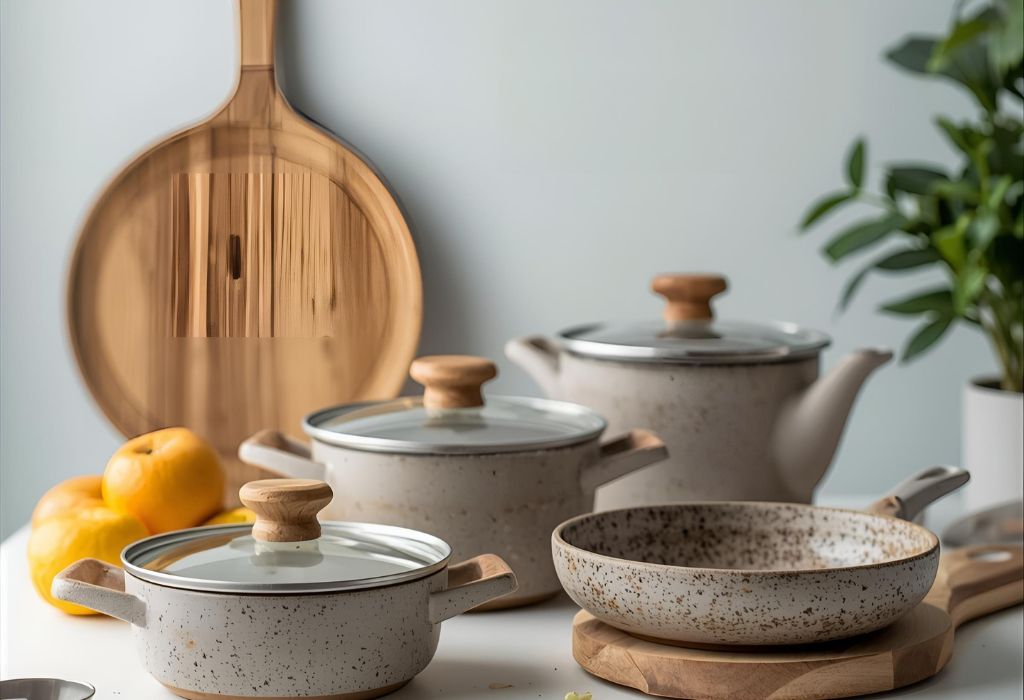
Regulations surrounding PFAS in cookware are evolving as awareness of health risks grows.
Some countries and U.S. states have already banned or restricted specific compounds like PFOA and PFOS, while thousands of other PFAS remain in use.
In the European Union, the European Food Safety Authority has set strict limits on PFAS exposure from food contact materials.
The U.S. Environmental Protection Agency has also issued new health advisories for PFAS in drinking water, signaling tighter oversight ahead.
California’s Proposition 65 requires cookware manufacturers to disclose the presence of harmful chemicals.
Washington State has gone further by passing laws to phase out PFAS in consumer products, including food-contact items.
These developments point toward a global shift in cookware safety standards.
Brands are being pushed to reformulate coatings, adopt independent testing, and market truly PFAS-free alternatives.
Consumers play a powerful role in driving these changes.
Rising demand for non-toxic, sustainable cookware encourages companies to innovate with safer materials and clearer labeling.
Q: Are there international laws regulating PFAS in cookware?
A: Yes, the EU and certain U.S. states enforce limits, but global standards remain inconsistent.
Q: Does the FDA regulate PFAS in ceramic cookware?
A: The FDA monitors food-contact materials, but oversight of ceramic coatings is still limited.
Q: Are more PFAS bans expected in the future?
A: Yes, growing scientific evidence is likely to result in broader restrictions worldwide.
Q: How are cookware brands responding to PFAS concerns?
A: Many are moving toward PFAS-free ceramic coatings and greater transparency.
Q: What trends will shape the future of cookware safety?
A: Stricter regulations, consumer demand for clean products, and innovations in nonstick technology will lead the way.
Conclusion
The question “does ceramic cookware have PFAS” highlights an issue that affects both health and consumer trust.
While true ceramic and porcelain enamel cookware are generally free from forever chemicals, ceramic-coated nonstick pans can vary depending on manufacturing practices and transparency.
The evidence shows that PFAS exposure carries long-term risks, including cancer, hormone disruption, and immune system effects.
Although cookware is only one potential source, avoiding PFAS in the kitchen is a practical step toward reducing overall exposure.
Choosing wisely means looking for PFAS-free and PTFE-free certifications, prioritizing pure ceramic options, and paying attention to brand transparency.
Proper use and care, such as avoiding overheating and replacing damaged cookware, also extend safety and performance.
As regulations tighten and consumer demand grows, the future points toward safer and more sustainable cookware options.
Until then, making informed decisions ensures healthier cooking and peace of mind at the table.
I’m Emma J. Caldwell, the founder, lead writer, and home-cooking enthusiast behind KitchenGuideCo.com. With a background in culinary arts and over a decade of cooking experience in both professional and personal kitchens, I created this platform to demystify recipes, offer smart kitchen gadget reviews, and guide readers through meal prep with confidence and clarity.

